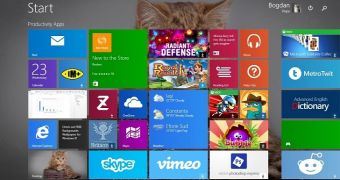There’s no doubt that after Windows Vista, Windows 8 is the most controversial Windows version that ever got to see daylight and the reasons should come as no surprise for those who have already decided to give it a try.
The removal of the Start button and the new Modern UI, which Microsoft has praised with every single occasion, turned Windows 8 into a very unfamiliar working environment that forced lots of users to stick to Windows 7 and avoid upgrading to this new OS release.
Windows 8 was launched approximately one and a half year ago, but the controversy regarding some of its features continues, despite Microsoft’s efforts to fix most of them and make its modern operating system the kind of product that could appeal to many more users.
But leaving all this criticism aside, Windows 8 is actually a sign of evolution and there’s no doubt that its successors follow the same trend and attempt to make Windows as we know it an operating system that can be used on multiple devices of different sizes.
Basically, Windows 8 is an operating system that tries to mix two different worlds: the one that’s using touch as the main input method and another one that still uses a mouse and keyboard. The first has the new Modern UI, while the latter still gets the desktop, without a Start button, but with pretty much everything that was included in Windows 7.
Now, I guess everyone knows that Metro is mostly aimed at devices with touch and although Microsoft has tried to change this in Windows 8.1 and 8.1 Update to make it more mouse-friendly, it still remains an environment that’s better on tablets than on PCs.
The desktop, on the other hand, is based on the exact same feature lineup as on Windows 7, so you have the same elements that you’ve gotten used to. And starting with Windows 8.1, there’s also a Start button, while a future update will also bring back the Start menu.
So, on one side, there’s the Modern UI, which may or may not come in handy to PC users, while on the other side, there’s the desktop that looks and works almost the same as on Windows 7.
So why the hate?
Believe it or not, Microsoft was absolutely right when it said that Windows 8 has all the things included in Windows 7 plus something extra. That little extra is the touch-optimized interface which, by the way, you can use or not, it all depends on your choice.
I’ve often heard that Windows 8 provides faster boot times, is more stable, and comes in handy to gamers out there, so it can successfully replace Windows 7 without too much pain. These comments came from people who actually installed Windows 8 and really gave it a chance.
Even though the Modern UI isn’t quite the best thing that could happen to the traditional PC, it’s still a matter of time until everyone gets used to it. It happened to each and every one of those running Windows 8 or 8.1 on a regular basis and with the improvements implemented with 8.1 Update, it’s all very mouse-friendly and easier to use.
To me, the modern Windows is a sign of evolution. It’s part of Microsoft’s long-term strategy that’s supposed to bring Windows on every single device out there, regardless its size. No matter if we want it or not, touch is part of our future and Windows doesn’t afford to be late to the party.
And according to existing speculation, Windows 9 is very likely to keep the same trend and focus on touch, while also tweaking the platform a little bit to better address the traditional PC.
In the end, it all comes down to users and the time they need to adapt to change. Of course, Windows 8 is not the perfect operating system, but the lack of a Start menu and the flat look aren’t quite the best things to complain about. There are plenty of other good options offered to users and, if you can’t really survive without a Start menu, there’s always a third-party app ready to help.
The market share that I’ve told you about so many times here on Softpedia ever since Windows 8 hit the shelves is not an indicative of how successful the operating system actually is. Microsoft hasn’t provided too many details about the number of sold licenses either, but let’s not forget that Windows also comes pre-installed on a number of new devices, so it’s a bit more difficult to decide whether it’s a hit or not.
I’m not trying to get into any sort of controversy and tell you that Windows 8 is better or worse than some other operating systems out there, but I truly believe that it’s not as bad as some people think. It’s not a disaster, it’s not a flop, and it’s certainly not the new Vista.
So before judging it as a bad product, just give it a shot, set it up the way you like and try, just try, to understand the idea behind the modern Windows concept.

 14 DAY TRIAL //
14 DAY TRIAL //